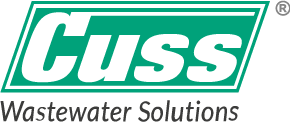Solid-liquid separation
In order to maintain the specified clear water values, the removal of solids in the water often plays an essential role. These suspended substances (TSS - "total suspended solids") can be, for example, fats from the food industry or activated sludge residues from biological treatment. In order to still achieve the required wastewater values, various technologies can be used. The effectiveness of these technologies can be increased by adding flocculants:
Circular scraper
A circular scraper is a large round sedimentation tank that is filled slowly and continuously. Particles can settle at the bottom of the basin, while clear water overflows and is discharged in a controlled manner. A slowly rotating scraper at the bottom of the basin removes the sedimented material. As this system is dependent on the sinking properties, floating and suspended matter such as grease must be removed beforehand. Circular scrapers are low-maintenance and can also treat large quantities of wastewater, which is why they are often used in municipal wastewater treatment plants. However, they take up a lot of space.
Chain scraper
The chain scraper works on the same principle as the circular scraper. The wastewater is brought to stagnation and solids can settle at the bottom of the tank. There, with the help of pushers attached to chains, these are transported into a sludge funnel and removed. Clear water is drawn off at the top of the system. As with other gravity-based technologies, the removal of floating or suspended matter is not possible.
Dissolved air flotation
In this process, gas is dissolved in the wastewater under pressure. During a subsequent abrupt drop in pressure, outgassing takes place. This produces very fine gas bubbles which, together with the smallest solids, form agglomerates and rise to the surface. The substances that collect on the surface can be cleared away. This process is used especially for the treatment of waste water containing fats and emulsions, e.g. from the dairy industry.
Lamella lamella separator
A lamella lamella separator uses the gravity-induced sinking of individual solid particles in the same way as a conventional sedimentation tank (circular scraper). The efficiency of the sedimentation process is increased by a system of slanted lamellas through which the water is guided. This significantly reduces the space requirement of the system. Suspended or floating substances such as grease cannot be separated by a lamella lamella separator. The principle is explained in the attached pictures.
Krählwerk
Excess sludge is produced during the biological treatment of wastewater. With a dry matter content of about 1%, considerable amounts of waste can accumulate. Dewatering to reduce the waste stream is absolutely necessary. As a preparatory step for dewatering, the sludge produced can be pre-thickened in a scraper mill. A scraper is similar in design and function to a circular scraper. The only difference is that floating sludge accumulating on the surface is also removed and the contents of the basin are mixed by agitated paddles.
Hydrocyclone
In a hydrocyclone, the wastewater flow is subjected to centrifugal forces through a gyroscopic movement. These centrifugal forces cause heavier particles to settle to the outside. Clear water can be drawn off in the centre of the cyclone. Similar to gravity separators, no floating substances can be removed (e.g. grease).
Gravel filter
In this technique, also called sand filtration, the pre-cleaned wastewater is passed through a bed of gravel and filtered by it. The water can be passed through the gravel bed from top to bottom (pressure filter) or from bottom to top (spatial filter). The working principle of both methods is the same. The water is filtered mechanically and solids remain in the gravel bed. The filter must be cleaned regularly by backwashing and requires regular maintenance. On the other hand, gravel filters are extremely effective and space-saving, even with larger wastewater volumes.
Activated carbon filter
An activated carbon filter works very similarly to a gravel filter. However, instead of passing through a sand bed, the water is passed through an activated carbon bed. In this way, larger particles are filtered out of the water. In addition, activated carbon has a reactive surface of 300-2000 m² per gram due to its porous structure resembling a sponge and its fine-grained form. Substances in the water are bound to this surface and removed from the water. In contrast to other filters, an activated carbon filter can also remove colourants or odorous substances dissolved in the water. However, regular cleaning of the filter and replacement or treatment (reactivation) of the activated carbon is necessary to maintain the purifying properties.

